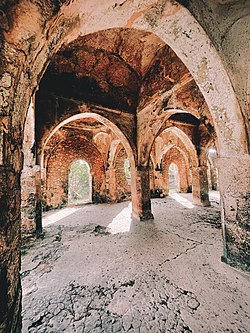
Back Kilwa Afrikaans جزيرة كلوة Arabic جزيرة كيلوا ARZ Kilwa Kisiwani AST Kilwa AVK Kilva-Kisivani Azerbaijani Кілва-Кісівані Byelorussian Килуа Bulgarian কিলওয়া কিসিওয়ানি Bengali/Bangla Kilwa Kisiwani Catalan
| Kilwa Kisiwani | |
|---|---|
 Great Mosque of Kilwa interior | |
| Type | Settlement |
| Location | Kilwa District, Lindi Region |
| Coordinates | 8°57′36″S 39°30′46″E / 8.9600°S 39.5128°E |
| Built | 9th century |
| Architectural style(s) | Swahili architecture |
| Governing body | Antiquities Division, Ministry of Natural Resources and Tourism[1] |
| Owner | Tanzania Government |
| Official name | Ruins of Kilwa Kisiwani and Ruins of Songo Mnara |
| Type | Cultural |
| Criteria | iii |
| Designated | 1981 (5th session) |
| Reference no. | 144 |
| UNESCO Region | Africa |
| Endangered | 2004–2014 |
| Official name | Kilwa Kisiwani Ruins |
| Type | Cultural |

Kilwa Kisiwani ('Kilwa Island') is an island, national historic site, and hamlet community located in the township of Kilwa Masoko, the district seat of Kilwa District in the Tanzanian region of Lindi in southern Tanzania. Kilwa Kisiwani is the largest of the nine hamlets in the town of Kilwa Masoko and is also the least populated hamlet in the township with around 1,150 residents.
At its peak in the Middle Ages, Kilwa had over 10,000 inhabitants. Since 1981, the entire island of Kilwa Kisiwani has been designated by UNESCO as a World Heritage Site along with the nearby ruins of Songo Mnara. Despite its significant historic reputation, Kilwa Kisiwani is still home to a small and resilient community of natives who have inhabited the island for centuries. Kilwa Kisiwani is one of the seven World Heritage Sites in Tanzania.[2] Additionally, the site is a registered National Historic Site of Tanzania.[3]
- ^ "Antiquities Division". Retrieved 21 Jul 2022.
- ^ "Ruins of Kilwa Kisiwani and Ruins of Songo Mnara". UNESCO World Heritage Centre. Retrieved 2021-07-24.
- ^ "Antiquities Sites" (PDF). Retrieved 21 Jul 2022.
